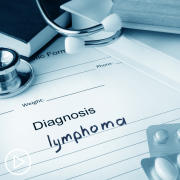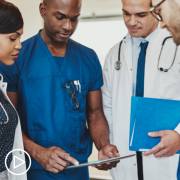Understanding Diffuse Large B-cell Lymphoma (DLBCL) and Its Subtypes from Patient Empowerment Network on Vimeo.
What should patients know about diffuse large B-cell lymphoma (DLBCL) and its subtypes? Expert Dr. Loretta Nastoupil defines DLBCL, discusses the subtypes of DLBCL and reviews the potential impact on treatment options.
Dr. Loretta Nastoupil is Director of the Lymphoma Outcomes Database in the Department of Lymphoma/Myeloma at The University of Texas MD Anderson Cancer Center. Learn more about Dr. Nastoupil, here.
See More From The Pro-Active DLBCL Patient Toolkit
Related Programs:
Transcript:
Katherine:
So, let’s start with a basic question, what is diffuse large B-cell lymphoma or DLBCL?
Dr. Nastoupil:
That’s a really important question. And I spend a lot of time when I first meet patients explaining to them there are a lot of different terms that are thrown around in lymphoma. Particularly, non-Hodgkin lymphoma is a term many patients will hear and even use. And I remind them that that is sort of an umbrella term that describes essentially every lymphoma that’s not Hodgkin lymphoma.
So, it’s really important to recognize that there are unique types of large cell lymphoma. And almost everything that we care about in terms of what the treatment will look like, whether or not we’re aiming to cure someone, or just maintain adequate disease control is primarily focused on the type of lymphoma someone has.
So, diffuse large B-cell lymphoma is the most common lymphoma subtype. Just in terms of its descriptive name, it is a B-cell cancer. And it is comprised of large cells that are essentially effacing or replacing the architecture of a lymph node.
There are different types, which I’m sure we’ll discuss. But, again, diffuse large B-cell lymphoma is our most frequent lymphoma we encounter.
Katherine:
What is B cell? What does that mean?
Dr. Nastoupil:
Sure. So, stepping back a little bit, I think most people when they know or have known someone with cancer, it is described as the organ it originates in. So, breast cancer’s a great example. That usually is breast tissue that is abnormal. It has malignant potential. And if it spreads beyond its capsule and specifically goes to a lymph node or another organ, generally that’s bad news.
Lymphoma is a cancer of the immune system. And there are various types of immune cells. B cells – they mature on and become plasma cells when they’re behaving normally. And their job is to generate antibodies so that we can develop immunity from exposures or infections we’ve had and we’ve recovered from.
So, if you develop a cancer in the B cell, depending what stage of development – if it’s a stem cell, for instance, that can lead to acute leukemia. If it’s an immature B cell, meaning it has not developed into a plasma cell, that’s, generally, where diffuse large B-cell lymphoma arises. So, these cells tend to live or spend most of their time in lymph nodes because they’re trying to mimic the behavior of a normal B cell where they’re waiting there for that exposure to happen.
So, these are generally not cancers that we try to cut out before they spread. They’re not spreading cancers in terms of how we generally think of those, meaning you’re not going to use surgery to treat it. And, oftentimes, there are malignant B cells kind of dispersed throughout the body because if you think about how your immune system should work, it should be able to fight off an infection anywhere and everywhere.
So, I think those are key things to keep in mind because oftentimes patients will have widespread involvement or lymph node involvement or bone involvement, and that’s just the nature of the disease and not necessarily something that is so far progressed we didn’t catch it early enough.
Katherine:
I see. Are there subtypes of DLBCL?
Dr. Nastoupil:
Yes, absolutely. So, again, stepping back, over the last 20 years, we have tried to understand why we’re able to cure about 60 percent of patients. But for the 40 percent that were not cured with standard treatment, their outcomes were generally poor, meaning most of those patients died as a result of their lymphoma.
And we’ve approached all of them the same. So, that would imply to us that there’s something inherently different about the large cell lymphoma cases that don’t respond to standard treatment. So, an attempt to try and define who those patients are before we initiate treatment, as technology has evolved, we’ve interrogated some of those biopsy samples to try and understand is there an underlying biologic rationale as to why some patients would have very, very disparate outcomes?
So, what we’ve learned is there are genes that are differentiated between different subtypes of large cell lymphoma. And we’ve described those subtypes based off those gene expression patterns. So, there is a germinal center type of large cell lymphoma. There’s a non-germinal center or activated B-cell type.
And then it gets much more complicated meaning there’s probably far more than just two subtypes. Right now, we’re describing at least five different subtypes. I think what’s important for patients to know is that we view this in terms of being able to predict who’s not going to have the typical course. And if we can define who they are, we might pursue something different, including potentially a clinical trial.
So, the subtypes I care the most about right now in terms of defining are the double hit or double expressors, those with other features that might lend itself to targeted therapy.
So, this is an evolving field and will continue I’m sure – that will have more subtypes defined over time.
















